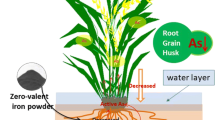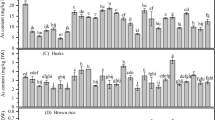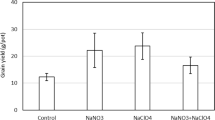Abstract
Being predominant inorganic arsenicals, methylarsenicals also occur in anaerobic paddy soils. Therefore, this study investigated the influence of Fe2+ concentrations and arsenic speciation [arsenate (As(V)) and dimethylarsinate (DMA)] in paddy soils on arsenic uptake in rice plant. Rice seedlings were grown in soil irrigated with a Murashige and Skoog (MS) growth solution containing As(V) or DMA with or without 1.8 mM Fe2+ in excess to the background concentration of total iron (0.03 mM) in the soil. Arsenic concentration in rice roots increased initially and then decreased gradually when the seedlings were grown with excess Fe2+ and As(V). In contrast, arsenic concentration in the roots increased steadily (P < 0.01) when the seedlings were grown without excess Fe2+ and As(V). When the form of the arsenic was DMA, total arsenic (tAs) concentration in rice roots increased gradually (P < 0.01) and was not affected by the addition of excess Fe2+ in the soil. When rice seedlings were grown with As(V), tAs concentration in rice roots and shoots increased steadily (P < 0.01) for gradual increase of Fe2+ concentrations in soil. However, tAs concentration in roots and shoots was independent of Fe2+ concentrations in soil when the form of arsenic was DMA. The tAs concentrations in rice shoots also increased significantly (P < 0.01) with increasing exposure time for both As(V) and DMA. Thus, Fe2+ concentrations in soil affect arsenic uptake in rice plant depending on the speciation of arsenic.






Similar content being viewed by others
References
Abedin, M. J., Feldmann, J., & Meharg, A. A. (2002). Uptake kinetics of arsenic species in rice plants. Plant Physiology, 128, 1120–1128.
Alam, M. B., & Sattar, M. A. (2000). Assessment of arsenic contamination in soils and waters in some areas of Bangladesh. Water Science and Technology, 185–192.
Ali, M. A., Badruzzaman, A. B. M., Jalil, M. A., Hossain, M. D., Ahmed, M. F., Masud, A. A., et al. (2003). Fate of arsenic extracted with groundwater. In M. F. Ahmed, M. A. Ali, & Z. Adeel (Eds.), Fate of arsenic in the environment (pp. 7–20). Dhaka: ITN International Training Network.
Bar-Ness, E., Hadar, Y., Chen, Y., Romheld, V., & Marschner, H. (1992). Short-term effects of rhizosphere microorganisms on Fe uptake from microbial siderophores by maize and oat. Plant Physiology, 100, 451–456.
Bentley, R., & Chasteen, T. G. (2002). Microbial methylation of metalloids: arsenic, antimony, and bismuth. Microbiology and Molecular Biology Reviews, 66, 250–271.
Blute, N. K., Brabander, D. J., Hemond, H. F., Sutton, S. R., Newville, M. G., & Rivers, M. L. (2004). Arsenic sequestration by ferric iron plaque on cattail roots. Environmental Science and Technology, 38, 6074–6077.
Brammer, H., & Ravenscroft, P. (2009). Arsenic in groundwater: a threat to sustainable agriculture in South and South-east Asia. Environmental International, 35, 647–654.
Chen, Z., Zhu, Y.-G., Liu, W.-J., & Meharg, A. A. (2005). Direct evidence showing the effect of root surface iron plaque on arsenite and arsenate uptake into rice (Oryza sativa) roots. New Phytologist, 165, 91–97.
Chowdhury, U. K., Biswas, B. K., Chowdhury, T. R., Samanta, G., Mandal, B. K., Basu, G. C., et al. (2000). Groundwater arsenic contamination in Bangladesh and West Bengal, India. Environmental Health Perspectives, 108, 393–397.
Christensen, K. K., & Sand-Jensen, K. (1998). Precipitated iron and manganese plaques restrict root uptake of phosphorus in Lobelia dortmanna. Botany, 76, 2158–2163.
Colmer, T. D. (2003). Long-distance transport of gases in plants: a perspective on internal aeration and radial oxygen loss from roots. Plant, Cell & Environment, 26, 17–36.
Crowley, D., Römheld, V., Marschner, H., & Szaniszlo, P. (1992). Root-microbial effects on plant iron uptake from siderophores and phytosiderophores. Plant and Soil, 142, 1–7.
Emerson, D., Weiss, J. V., & Megonigal, J. P. (1999). Iron-oxidizing bacteria are associated with ferric hydroxide precipitates (Fe-plaque) on the roots of wetland plants. Applied and Environmental Microbiology, 65, 2758.
Greipsson, S. (1994). Effects of iron plaque on roots of rice on growth and metal concentration of seeds and plant tissues when cultivated in excess copper. Communications in Soil Science and Plant Analysis, 25, 2761–2769.
Greipsson, S. (1995). Effect of iron plaque on roots of rice on growth of plants in excess zinc and accumulation of phosphorus in plants in excess copper or nickel. Journal of Plant Nutrition, 18, 1659–1665.
Hossain, M. F. (2006). Arsenic contamination in Bangladesh—an overview. Agriculture, Ecosystems and Environment, 113, 1–16.
Hu, Y., Li, J. H., Zhu, Y. G., Huang, Y. Z., Hu, H. Q., & Christie, P. (2005). Sequestration of As by iron plaque on the roots of three rice (Oryza sativa L.) cultivars in a low-P soil with or without P fertilizer. Environmental Geochemistry and Health, 27, 169–176.
Huang, J. H., & Matzner, E. (2006). Dynamics of organic and inorganic arsenic in the solution phase of an acidic fen in Germany. Geochimica et Cosmochimica Acta, 70, 2023–2033.
Ishimaru, Y., Suzuki, M., Tsukamoto, T., Suzuki, K., Nakazono, M., Kobayashi, T., et al. (2006). Rice plants take up iron as an Fe3+-phytosiderophore and as Fe2+. The Plant Journal, 45, 335–346.
Kraemer, S. (2004). Iron oxide dissolution and solubility in the presence of siderophores. Aquatic Sciences, 66, 3–18.
Li, R. Y., Ago, Y., Liu, W. J., Mitani, N., Feldmann, J., McGrath, S. P., et al. (2009). The rice aquaporin Lsi1 mediates uptake of methylated arsenic species. Plant Physiology, 150, 2071–2080.
Liu, W. J., Zhu, Y. G., Smith, F. A., & Smith, S. E. (2004a). Do iron plaque and genotypes affect arsenate uptake and translocation by rice seedlings (Oryza sativa L.) grown in solution culture? Journal of Experimental Botany, 55, 1707.
Liu, W. J., Zhu, Y. G., Smith, F. A., & Smith, S. E. (2004b). Do phosphorus nutrition and iron plaque alter arsenate (As) uptake by rice seedlings in hydroponic culture? New Phytologist, 162, 481–488.
Liu, W. J., Zhu, Y. G., Hu, Y., Williams, P. N., Gault, A. G., Meharg, A. A., et al. (2006). Arsenic sequestration in iron plaque, its accumulation and speciation in mature rice plants (Oryza sativa L.). Environmental Science and Technology, 40, 5730–5736.
Ma, J. F., Yamaji, N., Mitani, N., Xu, X. Y., Su, Y. H., McGrath, S. P., et al. (2008). Transporters of arsenite in rice and their role in arsenic accumulation in rice grain. Proceedings of the National Academy of Sciences of the United States of America, 105, 9931.
Marin, A. R., Pezeshki, S. R., Masschelen, P. H., & Choi, H. S. (1993). Effect of dimethylarsenic acid (DMAA) on growth, tissue arsenic, and photosynthesis of rice plants. Journal of Plant Nutrition, 16, 865–880.
Meharg, A. A., & Jardine, L. (2003). Arsenite transport into paddy rice (Oryza sativa) roots. New Phytologist, 157, 39–44.
Meharg, A. A., & Rahman, M. M. (2003). Arsenic contamination of Bangladesh paddy field soils: implications for rice contribution to arsenic consumption. Environmental Science and Technology, 37, 229–234.
Murashige, T., & Skoog, F. (1962). A revised medium for rapid growth and bio assays with tobacco tissue cultures. Physiologia Plantarum, 15, 473–497.
Murphy, E. A., & Aucott, M. (1998). An assessment of the amounts of arsenical pesticides used historically in a geographical area. Science of the Total Environment, 218, 89–101.
Neumann, R. B., St. Vincent, A. P., Roberts, L. C., Badruzzaman, A. B. M., Ali, M. A., & Harvey, C. F. (2011). Rice field geochemistry and hydrology: an explanation for why groundwater irrigated fields in Bangladesh are net sinks of arsenic from groundwater. Environmental Science and Technology, 45, 2072–2078.
Ninno, C. D., & Dorosh, P. A. (2001). Averting a food crisis: private imports and public targeted distribution in Bangladesh after the 1998 flood. Agricultural Economics, 25, 337–346.
Raab, A., Williams, P. N., Meharg, A., & Feldmann, J. (2007). Uptake and translocation of inorganic and methylated arsenic species by plants. Environmental Chemistry, 4, 197–203.
Rahman, M. A., Hasegawa, H., Ueda, K., Maki, T., & Rahman, M. M. (2008a). Arsenic uptake by aquatic macrophyte Spirodela polyrhiza L.: interactions with phosphate and iron. Journal of Hazardous Materials, 160, 356–361.
Rahman, M. A., Hasegawa, H., Ueda, K., Maki, T., & Rahman, M. M. (2008b). Influence of phosphate and iron ions in selective uptake of arsenic species by water fern (Salvinia natans L.). Chemical Engineering Journal, 145, 179–184.
Rahman, M. A., Kadohashi, K., Maki, T., & Hasegawa, H. (2010). Transport of DMAA and MMAA into rice (Oryza sativa L.) roots. Environmental and Experimental Botany, 72(1), 41–46.
Rahman, M. A., Rahman, M. M., Kadohashi, K., Maki, T., & Hasegawa, H. (2011). Effect of external iron and arsenic species on chelant-enhanced iron bioavailability and arsenic uptake in rice (Oryza sativa L.). Chemosphere, 84, 439–445.
Romheld, V., & Marschner, H. (1986). Evidence for a specific uptake system for iron phytosiderophores in roots of grasses. Plant Physiology, 80, 175–180.
Smith, A. H., Lingas, E. O., & Rahman, M. (2000). Contamination of drinking-water by arsenic in Bangladesh: a public health emergency. Bulletin of the World Health Organization, 78, 1093–1103.
Takahashi, Y., Minamikawa, R., Hattori, K. H., Kurishima, K., Kihou, N., & Yuita, K. (2004). Arsenic behavior in paddy fields during the cycle of flooded and non-flooded periods. Environmental Science and Technology, 38, 1038–1044.
Takamatsu, T., Aoki, H., & Yoshida, T. (1982). Determination of arsenate, arsenite, monomethylarsonate, and dimethylarsinate in soil polluted with arsenic. Soil Science, 133, 239.
Wang, T., & Peverly, J. H. (1999). Iron oxidation states on root surfaces of a wetland plant (Phragmites australis). Soil Science Society of America Journal, 63, 247–252.
Wang, J., Zhao, F. J., Meharg, A. A., Raab, A., Feldmann, J., & McGrath, S. P. (2002). Mechanisms of arsenic hyperaccumulation in Pteris vittata: uptake kinetics, interactions with phosphate, and arsenic speciation. Plant Physiology, 130, 1552.
Ward, J. T., Lahner, B., Yakubova, E., Salt, D. E., & Raghothama, K. G. (2008). The effect of iron on the primary root elongation of Arabidopsis during phosphate deficiency. Plant Physiology, 147, 1181–1191.
Williams, P. N., Islam, M. R., Adomako, E. E., Raab, A., Hossain, S. A., Zhu, Y. G., et al. (2006). Increase in rice grain arsenic for regions of Bangladesh irrigating paddies with elevated arsenic in groundwaters. Environmental Science and Technology, 40, 4903–4908.
Xu, X. Y., McGrath, S. P., & Zhao, F. J. (2007). Rapid reduction of arsenate in the medium mediated by plant roots. New Phytologist, 176, 590–599.
Zhang, X., Zhang, F., & Mao, D. (1998). Effect of iron plaque outside roots on nutrient uptake by rice (Oryza sativa L.). Zinc uptake by Fe-deficient rice. Plant and Soil, 202, 33–39.
Zhao, F. J., McGrath, S. P., & Meharg, A. A. (2010). Arsenic as a food chain contaminant: mechanisms of plant uptake and metabolism and mitigation strategies. Annual Review of Plant Biology, 61, 535–559.
Zhu, Y. G., Williams, P. N., & Meharg, A. A. (2008). Exposure to inorganic arsenic from rice: a global health issue? Environmental Pollution, 154, 169–171.
Acknowledgments
The research was funded partly by the Japan Society for the Promotion of Science as Grants-in-Aid for Scientific Research (20·08343). The first author also wishes to thank the University of Technology, Sydney (UTS) for the financial support. The authors would like to thank Dr. Anne Colville, from the School of Environmental Sciences, UTS, Australia, for reviewing the manuscript prior to submission in the journal.
Author information
Authors and Affiliations
Corresponding author
Rights and permissions
About this article
Cite this article
Rahman, M.A., Hasegawa, H., Rahman, M.M. et al. Effect of Iron (Fe2+) Concentration in Soil on Arsenic Uptake in Rice Plant (Oryza sativa L.) when Grown with Arsenate [As(V)] and Dimethylarsinate (DMA). Water Air Soil Pollut 224, 1623 (2013). https://doi.org/10.1007/s11270-013-1623-0
Received:
Accepted:
Published:
DOI: https://doi.org/10.1007/s11270-013-1623-0




